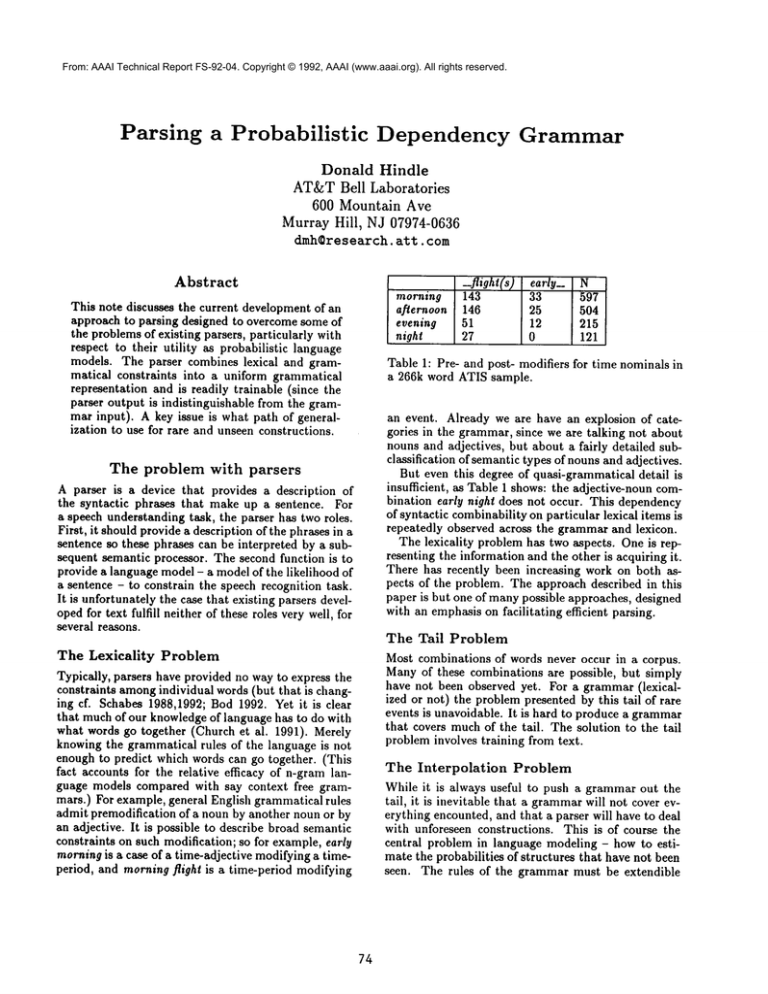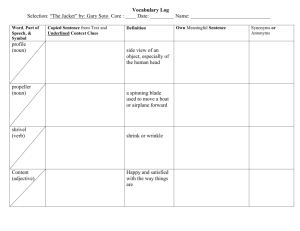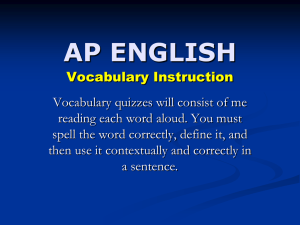
From: AAAI Technical Report FS-92-04. Copyright © 1992, AAAI (www.aaai.org). All rights reserved.
Parsing
a Probabilistic
Dependency
Grammar
Donald
Hindle
AT&T Bell Laboratories
600 Mountain Ave
Murray Hill, NJ 07974-0636
dmh@research, att. com
_flight(s)early_
Abstract
morning
143
af-le~oon146
evening
51
night
27
This note discusses the current development of an
approach to parsing designed to overcome some of
the problems of existing parsers, particularly with
respect to their utility as probabilistic language
models. The parser combines lexical and grammatical constraints into a uniform grammatical
representation and is readily trainable (since the
parser output is indistinguishable from the grammar input). A key issue is what path of generalization to use for rare and unseen constructions.
The
problem
with
N
597
504
215
121
Table 1: Pre- and post- modifiers for time nominals in
a 266k word ATIS sample.
an event. Already we are have an explosion of categories in the grammar, since we are talking not about
nouns and adjectives, but about a fairly detailed subclassification of semantic types of nouns and adjectives.
But even this degree of quasi-grammatical detail is
insufficient, as Table 1 shows: the adjective-noun combination early night does not occur. This dependency
of syntactic combinability on particular lexical items is
repeatedly observed across the grammarand lexicon.
The lexicality problem has two aspects. One is representing the information and the other is acquiring it.
There has recently been increasing work on both aspects of the problem. The approach described in this
paper is but one of manypossible approaches, designed
with an emphasis on facilitating efficient parsing.
parsers
A parser is a device that provides a description of
the syntactic phrases that make up a sentence. For
a speech understanding task, the parser has two roles.
First, it should provide a description of the phrases in a
sentence so these phrases can be interpreted by a subsequent semantic processor. The second function is to
provide a language model - a model of the likelihood of
a sentence - to constrain the speech recognition task.
It is unfortunately the case that existing parsers developed for text fulfill neither of these roles very well, for
several reasons.
The Lexicality
33
25
12
0
The Tail Problem
Most combinations of words never occur in a corpus.
Manyof these combinations are possible, but simply
have not been observed yet. For a grammar (lexicalized or not) the problem presented by this tail of rare
events is unavoidable. It is hard to produce a grammar
that covers muchof the tail. The solution to the tail
problem involves training from text.
Problem
Typically, parsers have provided no way to express the
constraints amongindividual words (but that is changing cf. Schahes 1988,1992; Bod 1992. Yet it is clear
that muchof our knowledgeof language has to do with
what words go together (Church et al. 1991). Merely
knowing the grammatical rules of the language is not
enough to predict which words can go together. (This
fact accounts for the relative efficacy of n-gram language models compared with say context free grammars.) For example, general English grammatical rules
admit premodification of a noun by another noun or by
an adjective. It is possible to describe broad semantic
constraints on such modification; so for example, early
morningis a case of a time-adjective modifying a timeperiod, and morning flight is a time-period modifying
The Interpolation
Problem
While it is always useful to push a grammar out the
tail, it is inevitable that a grammarwill not cover everything encounted, and that a parser will have to deal
with unforeseen constructions. This is of course the
central problem in language modeling - how to estimate the probabilities of structures that have not been
seen. The rules of the grammar must be extendible
74
From: AAAI Technical Report FS-92-04. Copyright © 1992, AAAI (www.aaai.org). All rights reserved.
to new constructions. In this parser the approach is
through analogy, or memory-basedreasoning (Stanfill
1986). But it is no simple matter to make the correct
analogy available to the parser. The choice of grammar can make considerable difference in the efficacy of
a language model, as discussed below.
The parser
A parseris beingdeveloped
to addressthe problems
outlinedabove.The grammarfor the parseris expressed
as a setof treesthathavelexically
specified
terminals,
eachwitha frequency
countbasedon the
training
corpus.Hindle(1992)reported
a version
thisparsertrained
fortheDARPAATIStaskconsistingof 14000grammar
trees.
Thebasic
parser
datastructure
isa listofnodeswith
a pointer
toa node,theparser’s
focusofattention.
The
basicoperation
is to combinethefocusednodewith
eitherthepreceding
or following
element
to createa
new node,updating
preceding
and following
pointers
andupdating
thefocusof attention
andthenrepeat.
If
no combination
ispossible,
thefocusis movedforward,
and thusparsingproceeds
fromthe beginning
of the
sentence
to theend.
One consequence
of thismodel:no non-contiguous
dependencies
arepicked
upby thisstageof theparser.
Theideaisthattheparser
isa reactive
component.
Its
output
is notthecomplete
analysis
of a sentence,
but
ratherconsists
of a setof fragments
thatsubsequent
processing
willgluetogether.
(cf.Abney1990,Jacobs
1990,Marcus1991).
The basicparseroperation
is to combinesubtrees
by matchingexistingtreesin the grammar.This
is straightforward
whenthe sentenceto be parsed
matches
treesin thegrammar,
buttypically,
theanalysisof a sentence
willrequire
reference
bothtotrees
thatare in thegrammar
andto treesthatarenotin
the grammarbut are likeonesin the grammar.
That
is,mostsentences
havenotbeenseenverbatim
previously.
Whenthe parserfindsno exactway to combine
two
nodesto matcha treethatexistsin thegrammar,
it
looksfor similartreesthatcombine.
Therearetwo
approaches
to deciding
whatto do in thesecases.
Thefirstapproach
(described
in Hindle1992)is
lookfor the exemplarin the grammarmostsimilar
tothecurrent
parsing
state(cf.Skousen
1989,Stanfill
1986).Theparser
usesa heuristically
defined
measure
of similarity
thatdepends
on: category,
root,type,
specifier,
anddistribution.
Theaimof thesimilarity
measure
is to determine
whatin general
contributes
to
thesimilarity
ofwords.
A second
approach
is to classify
treesinthegrammar
according
theheuristic
factors
notedabove,
andto find
theaverage
behavior
of eachclass,andthenin parsingto matchthemostspecific
reference
class,
rather
thanthe nearestexemplar.
Preliminary
experiments
suggested
thatthisapproach
givesa lowerperplexity
75
modelthanthe analogical
approach
described
in Hindle1992,butthereareimportant
priorissuesto be
resolved
for:either
implementation.
Thedetails
of the
current
similarity
metric
arelargely
arbitrary,
butitis
critical
sinceiftheparser
chooses
a suboptimal
exemplarorgeneralizes
to a suboptimal
class,
themodelis
considerably
degraded.
Grammar and generalization
Dependencygrammars of the sort assumed for the current parser have considerable surface plausibility, but
certain syntactic relationships are problematic. For example, for both noun phrases and verb phrases there
are two competing dependency descriptions,
both of
which seem intuitively
plausible. For noun phrases
the head may be taken to be either 1) the head noun
(e.g. "man" in "the MEN"),or 2) the determiner (e.g.
"the" in "THEmen"); analogously, for verb phrases,
the head may be taken to be either 1) the main verb
(e.g. "see" in "had SEEN")or 2) the tensed verb
the verb group (e.g. "have" in "HADseen").
The grammarfor the parser may be written with either view of the heads of noun and verb phrases, but
these two models imply different natural generalizations or analogies for the parser, and thus make different predictions about the language probabilities. If
the determiner is taken to be the head of the noun
phrase, then in guessing the probability of a verbdet-noun structure, the association between the verb
and the determiner will predominate; if we don’t have
enough information about the triple we can back off to
pairs. Conversely, if the noun is taken to be the head
of the noun phrase, then the predominant association
will be between verb and noun. (Of course, the details
of implementation of the analogy or class generalization model may override these natural interpretations
of the grammar.)
A ten million word sample of Wall Street Journal
text (distributed by the ACL-DCI)was parsed, and
set of verb-determiner-noun triples extracted. Specifically, object noun phrases consisting of a noun preceded by a single determiner preceded by a verb were
tabulated. The five most commonsuch triples (preceded by their counts) were:
213 have
a
loss
176 be
the first
165 be
a
unit
140 raise
its
stake
127 reach an
agreement
Three different probability models were investigated
for this data set, and their entropies calculated (Table 2). In each case, we assume that we have a verb
with an object and that the object has a determiner
and a noun. The task of the model is to predict the
specific verb, determiner and preposition in this verbdeterminer-noun triple. Model 0 is the baseline trigram model, assuming no independence among the
three terms. Model1, the natural model for the deter-
From: AAAI Technical Report FS-92-04. Copyright © 1992, AAAI (www.aaai.org). All rights reserved.
Model
for
[.. d. ]]
0 pr(vdn) = pr(v) pr(dnlv)
1 pr(vdn) ~ pr(v) * pr(dlv ) *) pr(nld
2 pr(vdn) ~ pr(v) * pr(nlv ) * pr(dln)
Entropy
15.08
20.48
17.62
Modelfor [vP v [NP d n ]]
0 pr(vdn) = pr(v) * pr(dnlv)
1 pr(vdn) ~. pr(v) * pr(dlv ) *) pr(nld
2 pr(vdn) ~ pr(v) * pr(nlv ) * pr(dln)
Entropy
15.50
22.74
19.55
Table 3: Three predictive models for 45,801 singleton
verb-det-noun triples in Wall Street Journal text.
Table 2: Three predictive models for verb-det-noun
triples in Wall Street Journal text.
Church, Kenneth W., William A. Gale, Patrick
Hanks, and Donald Hindle. (1991). Using statistics
in lexical analysis, in Zernik (ed.) Lezical acquisition: exploiting on-line resources to build a lexicon.
Lawrence Erlbaum.
Hindle, Donald. 1992. An analogical parser for restricted domains. In Proceedings of the Fifth DARPA
Workshop on Speech & Natural Language.
Jacobs, Paul. 1990. To parse or not to parse: relationdriven text skimming. In COLING90, 194-198,
Helsinki, Finland.
Marcus, Mitchell P. and Donald Hindle. 1990. Description Theory and Intonation Boundaries. In Gerald Altmann (ed.), Computational and Cognitive
Models of Speech. MIT Press.
Sadler, Victor. 1989. Working with analogical semantics. Foris: Dordrecht.
Schabes, Yves. 1988. Parsing strategies with ’lexicalized’ grammars: application to tree adjoining grammars. In Proceedings of the 12th International Conference on Computational Linguistics,
COLING88,
Budapest, Hungary.
Schabes, Yves. 1992. Stochastic lexicalized treeadjoining grammars. COLING-92,425-431.
Skousen, Royal. 1989. Analogical modeling of language. Kluwer:Dordrecht.
Stanfill,
Craig and David Waltz. 1986. Toward
memory-based reasoning.
Communications of the
ACM29.12.
miner=head model, predicts the determiner from the
verb and the noun from the determiner. Model2 is the
converse, the natural model for the noun=head model.
Both Model 1 and Model 2 throw out information, assumingin the first ease that the choice of noun is independent of the verb, and in the second case, that the
choice of determiner is independent of the verb. Neither assumption is warranted, as Table 2 shows (both
have higher entropy than the trigram model), but the
determiner=head is considerably inferior.
Model 1 is for this particular case like a bigram
model. Table 2 makes clear that this is not a particularly good way to model dependencies between verb
and object: the dominant dependency is between verb
and noun,
None of these models corresponds well to a standard stochastic context free grammar, where the association between hxical items is typically obliterated
by the context free rewriting. It is clear from the difference between Model 0 and Model 1 that this represents a significant loss of information. The problem
is in fact minimized in these tables, since the dependency of noun on determiner and vice versa was calculated for object NP’s only. This table makesit clear
why neither an ngram model nor a standard stochastic
context free grammarprovides a particularly effective
language model.
With a tree based grammar, the frequent cases
are not a problem , since the interactions
are refleeted in the lexicalized trees, and we can get rather
good estimates of their probabilities.
Nevertheless,
using lexicalized trees in our grammardoes not protect us from rare cases. In our WSJsample, nearly
half of the observed V-D-Ntriples occurred only once
(45801/96305). For the triples that occur only once
not at all, our maximum
likelihood estimate is not very
good, and the problem still arises how to interpolate.
Table 3 is similar to Table 2, showingthat for the singleton case, there are dependencies both between verb
and determiner and between verb and noun, and that
the latter are stronger.
References
Abney, Steven P. Rapid incremental parsing with repair. Paper presented at Waterloo conference on Electronic Text Research.
Bod, Rens. Data oriented parsing (DOP). COLING92,855-859.
76








